It’s winter but despite the cold, it’s pleasing to see that training numbers have remained high – particularly the bravehearts who try to warm the freezing mat at the 6:30am classes. ASC’s 17th. Anniversary Seminar is coming soon so please do attend that and look forward to the year end grading in November.
Editor
A few thoughts…… On training
It is obvious that to learn aikido we must practice. It is also obvious that the more we practice aikido the more we learn. But what and how we practice in aikido is an important part of the equation determining what we learn.
Here are some simple points & notes of how to approach training rather than just technical tips:
WHAT we must practice in aikido are the basic techniques. Don’t waste time trying to remember tricky or unusual techniques, they can be fun but they don’t lead anywhere.
A good understanding of the basic techniques, particularly ikkyo, shihonage and iriminage, will provide you with a basis to execute most aikido techniques well. As you train you should consistently search for even infinitesimal improvements in these basics by regularly practicing various aspects e.g. a particular cut or hand change, footwork or body position. This will lead to more efficient and effective techniques and increased power.
HOW we practice is critical. Approach every training session with a fresh eye and mind. You ideally should take each session with the same mind & thirst for knowledge that you had as a beginner. Can you remember what this was like? Don’t let your practice become sterile repetition.
Keep your practice “alive”. Make the effort to understand what the instructor is trying to teach you; don’t fall into a habit but rather be prepared to challenge yourself and throw out old ideas. Experiment with basic techniques – try doing things differently for a while [for 6 months or more] to test whether something is worthwhile. As an aside, sometimes, this is where an injury can be useful as it forces you to do things differently for a while.
Be very patient – Your aikido development will not be linear but rather your understanding will advance in “fits and jumps”. Every so often, a “light” of understanding will switch on. Those moments are very satisfying. But you must have the determination to keep practicing hard through those times when you seem to be making little progress or those flashes of insight will be few and far between. If you are determined & practise basics consistently you will develop a higher level aikido.
Andrew Williamson Sensei
O’ SENSEI – A BRIEF BIOGRAPHY
Nowadays there is a great deal of material on Aikido in both books and on the internet and we encourage you all to read about the history of the art we practice. Perhaps the key person to understand is of course O’ Sensei the founder and first head of aikido. To that end we have put together a brief biography of his life. For more in depth information we suggest people start with the sources listed below.
MORIHEI UESHIBA
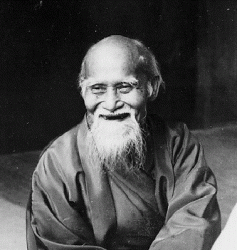 O’Sensei
O’Sensei
- 1883 Born in Tanabe the son of Yoroku and Yuki Ueshiba [Note: Tanabe is the site for the 2008 IAF conference and seminar] Early years studied a number of martial arts
- 1903-06 Entered the military during the Russo-Japanese war.
- 1911 relocated to Hokkaido as a pioneer settler. Faced intense hardships.
- 1915 Began studying Daito Ryu under Sokaku Takeda and continued an association with him until about 1937.
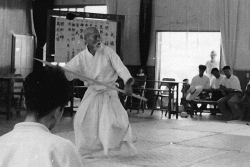 1919 Met Onisaburo Deguchi the then head of the Omoto religion
1919 Met Onisaburo Deguchi the then head of the Omoto religion- 1920 – 7 Lived in Ayabe as an active and close supporter of Deguchi
- 1921 His son Kisshomaru was born.
- 1924 Travelled with Deguchi to Mongolia in a failed attempt to establish a utopian colony.
- 1927 Relocated to Tokyo at the urging of several high ranking naval officers including Admiral Isamu Takeshita.
- 1931 Established the first Kobukan Dojo [on the site of the present Hombu dojo to t each what ultimately would become aikido. During the 1930s O Sensei separated his activities from Sokaku Takeda.
- 1936 Noma Dojo demonstration series filmed providing an extensive photographic record of O Sensei’s training from this period.
- 1941 The name ‘Aikido’ became to be used to describe the art O Sensei and others were practising. War was declared with the US
- 1942 O Sensei ‘retired’ to Iwama, farmed and continued developing aikido. Lived frugally in a converted shed.
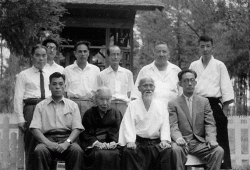 Iwama Shrine 1945 After the war the Tokyo HQ dojo was damaged and occupied by homeless families. The prewar practitioners had been scattered by the war. O Sensei spent most of his time in Iwama. His son Kisshomaru Ueshiba was in charge of the HQ.
Iwama Shrine 1945 After the war the Tokyo HQ dojo was damaged and occupied by homeless families. The prewar practitioners had been scattered by the war. O Sensei spent most of his time in Iwama. His son Kisshomaru Ueshiba was in charge of the HQ. - 1948 The Aikikai Foundation with the HQ in Iwama was recognised by the Japanese Government and practice resumed in Tokyo. Kisshomaru Ueshiba put in charge of administration and the development of aikido.
- 1950s- O Sensei spent more time in Tokyo and many students resumed training. New students joined.
- 1951 Wakayama photographic series taken of O’ Sensei.
- 1954 Aikikai HQ formally returns to Tokyo
- 1956 First Aikikai sponsored public demonstration held on top of the Takashimaya Department store
- 1960 Sensei received the Medal of Honour with the purple ribbon from the Japanese Government.
- The first All Japan Aikido Demonstration Meet was held and became an annual event.
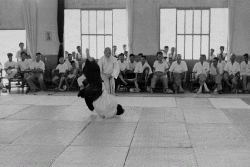 1960s Aikido expanded nationwide and into the universities.
1960s Aikido expanded nationwide and into the universities.- 1961 O’ Sensei visited Hawaii
- 1967 Work started on the present Hombu and completed late in the year.
- 1969 Fell ill with liver cancer and died on April 26.
Bibliography:
Aikido Journal www.aikidojournal.com
K. Ueshiba Aikido (Kodansha 1985)
K. Ueshiba Founder of Aikido Memorial Photo Collection (1983, World Aikido HQ)
Andrew Williamson Sensei
Christchurch
DESTINATION BRISBANE
As some of you know, and some may just be wondering where I am because they haven’t seen me at the dojo in a while, I have relocated to Brisbane in sunny Queensland, Australia. The March ‘07 Auckland gasshuku was my last stop on the way over here.
I am now working as a massage therapist full time (yes that’s 5 days a week) with my two younger brothers here at Race Elements, which is panning out really well (along with our plans to take over Qld… and the world). I work a couple of evenings which makes getting to Aikido unachievable on those nights, but I am going regularly to a couple of morning classes (something about having coffee afterwards!) and one or two evenings also.
Training Differences
The temperature is cooling down now, still warm by Christchurch standards. I’ve ceased using my sweaty gi pants as a post training towel in the last few weeks, and I do enjoy the half time water breaks (no oranges though) – it’s a good chance to catch my breath and pretend I can handle the pace!
We usually do misogi breathing and fune kogi at the start of each class, which is a nice way to begin, I must say. Just as in Christchurch there is a generous mix of nationalities training here too. Japanese, English, Kiwi, Chilean, American and a few Aussies (BUT) no one from Brazil (at last!! that’s you Lui!)
Of course, there are other differences too, which you always find when ever you train somewhere else, etiquette, intensity, personalities and the list goes on but that’s what makes training elsewhere interesting and enjoyable, and you can take those new experiences with you.
Life in General
Here’s a brief list of personal “achievements” and natural phenomena since I’ve been here:- I’ve moved once; I don’t have a car; I ride a borrowed bike; I use the trains from time to time; I’ve been in contact with both Ben Hayward (Christchurch dojo) who is living in central Victoria and Roland Stettler (Dunedin dojo) now a full time Dentist in Gladston, Qld; I haven’t had a beer for a week; it’s rained three times in two months, one of which was for two consecutive night, but we’re still on level 5 water restrictions – that’s about 140L per person per day and I’ve mastered the 4 minute shower; I’ve been out on the town about 4 times (I think); I’m eating well; and yes, I have spoken to Mum and Dad!
I do have one of my priorities right though – I’m only an easy 15 minute ride from the Dojo. And I’ll be off to the Gold Coast Aikido Winter School on the 5th and 6th of July with a few of the guys from Brisbane! (have been, by now! – ed)
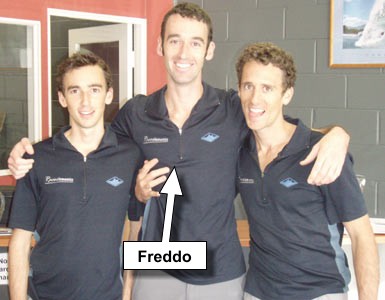
Alex (Freddo) Frederiksen
Brisbane
http://www.raceelements.com.au/
SHODANS-IN-WAITING – a perspective
DAVID
A four year cosy journey through Aikido towards shodan – HAHAHA tricked y’all! You didn’t really believe that my journey up till now has been cosy, did ya? Did ya?! Aikido is not a pinochle*! It is a Japanese martial art!!
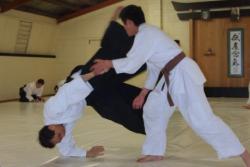 The past 4 years which I have been training have been rather……dynamic……and challenging, both physically and mentally. My thoughts after the first week of training kept going back to the large list of hard techniques that I would have to learn and whacky (Japanese) names that accompanied them. I never would have imagined that I would make it to ikkyu…….but guess what? I made it!! Also, I started off with the same typical question that so many beginners have asked me – how long does it take to get a black belt? After several months of training and understanding the art, it plagued me that learning aikido (and other martial arts, I presume) was much more than gaining the high status, wearing a black piece of cloth around your waist and, in aikido’s case, a fancy unisex skirt.
The past 4 years which I have been training have been rather……dynamic……and challenging, both physically and mentally. My thoughts after the first week of training kept going back to the large list of hard techniques that I would have to learn and whacky (Japanese) names that accompanied them. I never would have imagined that I would make it to ikkyu…….but guess what? I made it!! Also, I started off with the same typical question that so many beginners have asked me – how long does it take to get a black belt? After several months of training and understanding the art, it plagued me that learning aikido (and other martial arts, I presume) was much more than gaining the high status, wearing a black piece of cloth around your waist and, in aikido’s case, a fancy unisex skirt.
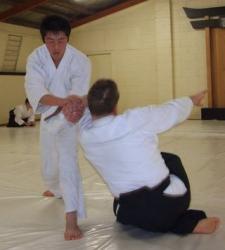 As for my aiki-testimony, my journey started off in February 2003 at the annual open day that the club had organised. Back then, I lived down the road from the dojo and I had come in with my dad to watch what aikido was all about. I remember I had a broken finger that day and Terry tried to drag me on to the mat. But me, being the shy guy I was, stubbornly refused. Anyway, that was the first time ever that I had seen aikido. My first impressions? Aikido is a bone-breaking and pain-enduring sport. Irimi-nage looked kind of like ballet and nikyo (with the kebab skewer analogy) made me shiver watching the pain on uke’s face. And Andrew Sensei, who was speaking, seemed like a pretty cool guy. Obviously, first impressions change**! As I developed, the training, techniques and their subtle points really amazed me. Who would have imagined that hips could do anything cooler than boogieing?
As for my aiki-testimony, my journey started off in February 2003 at the annual open day that the club had organised. Back then, I lived down the road from the dojo and I had come in with my dad to watch what aikido was all about. I remember I had a broken finger that day and Terry tried to drag me on to the mat. But me, being the shy guy I was, stubbornly refused. Anyway, that was the first time ever that I had seen aikido. My first impressions? Aikido is a bone-breaking and pain-enduring sport. Irimi-nage looked kind of like ballet and nikyo (with the kebab skewer analogy) made me shiver watching the pain on uke’s face. And Andrew Sensei, who was speaking, seemed like a pretty cool guy. Obviously, first impressions change**! As I developed, the training, techniques and their subtle points really amazed me. Who would have imagined that hips could do anything cooler than boogieing?
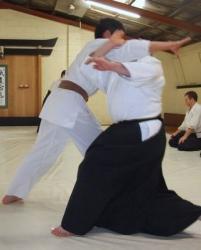 During my years of training, I have watched myself and others developing proficiency in our techniques, moving up the ranks and offering their skills back for the beginners to have a crack. It is truly awesome watching the gradings every half year, congratulating each and every student after their test, acknowledging their improvement and the endless effort that the senseis have put in the get them to that stage……then thinking ‘Hey wait a sec……I was that grade once before too’ and then realising how far you have actually come.
During my years of training, I have watched myself and others developing proficiency in our techniques, moving up the ranks and offering their skills back for the beginners to have a crack. It is truly awesome watching the gradings every half year, congratulating each and every student after their test, acknowledging their improvement and the endless effort that the senseis have put in the get them to that stage……then thinking ‘Hey wait a sec……I was that grade once before too’ and then realising how far you have actually come.
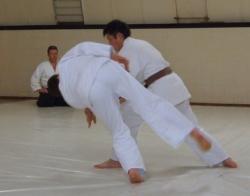 Training at Aikido Shinryukan Canterbury has been a rewarding experience. Our dojo houses many skilful sensei and expectations are high. This guarantees that we raise the legendary aikido-ka for the future generation of trainees. Sounds awesome, no? The journey so far, although arduous, has been recompensed with understanding and development. I now know that patience is indeed a virtue and I have been rewarded with many friendships struck and the priceless knowledge and experience gained with training with our local and international sensei, each their own unique doctrine. There is so much more out there in the world of Aikido to learn and now I can only look forward to what my aiki-future has in store for me.
Training at Aikido Shinryukan Canterbury has been a rewarding experience. Our dojo houses many skilful sensei and expectations are high. This guarantees that we raise the legendary aikido-ka for the future generation of trainees. Sounds awesome, no? The journey so far, although arduous, has been recompensed with understanding and development. I now know that patience is indeed a virtue and I have been rewarded with many friendships struck and the priceless knowledge and experience gained with training with our local and international sensei, each their own unique doctrine. There is so much more out there in the world of Aikido to learn and now I can only look forward to what my aiki-future has in store for me.
So what advice do I have to give?
Train hard! Strive! Never give up! And never doubt yourself! You can make it!
* pronounced “pee-knuckle” – thumb-wrestling
** Andrew Sensei is still cool by the way (yeah right! – sucking-up to mitigate retribution from indiscreet use of a cellular device! – ed)
*** David is also cool
Your friendly neighbourhood aikido-ka
David Lim***
Christchurch
ALEX
As a young twelve-year-old boy I began training in Aikido, having absolutely no idea of the path that lay ahead. I was ungraded and particularly young, and for the first few months of my Aikido training, everyone was very nice. The biggest challenge of being an absolute low grade was grasping the concepts, and of course the names, of three kihon techniques and a few exercises and footwork, but applying the techniques effectively was not a concern. There was a particularly helpful brown belt at the time, called Shane, and I always felt that whenever I trained with Shane I learned something of paramount importance, such as keeping my fingers apart when in stance, and keeping my front foot straight or turned out slightly, so as not to roll on my ankle.
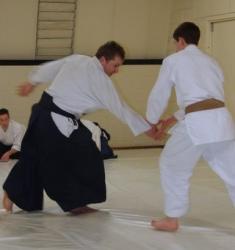 But of course those happy days could not last, and change was imminent, foreshadowed by such symbols of my progress as an Aikidoka as my improving proficiency test marks and my acquisition of my first Gi. I became graded, a Rokkyu, and everything changed. Shane, once a library of Aikido knowledge, was now more like an ogre, although to be fair I must admit my own ceaseless fire of smartass comments, which today are vaguely reminiscent of most things Miko says to me. Andrew also became a figure of intimidation, but not in the same way as Shane. And then there was Yonkyo, the bane of my life. That technique seemed to me to have been created out of pure evil, especially because it never really worked when I tried to use it myself. Other than this, I have very little memory (due to underage abuse of long blacks! – ed) of my time as a graded white belt. Change in my techniques and ability as both an Uke and Nage seemed to come so slowly during this period that at any one point in time I was surely not improving, but somehow I got a little bigger, less susceptible to the various wrist locks of Aikido, and more proficient in techniques. My favourite technique was Shiho Nage, I think, or it might have been Irimi Nage, but my particular skill in Aikido seemed to me to be in receiving techniques, or so it seemed, as Shane must have had good faith in my Ukemi to throw me as powerfully as I think he did (Andrew was usually more careful, although Mum was always worried by the Yonkyo bruises he gave me).
But of course those happy days could not last, and change was imminent, foreshadowed by such symbols of my progress as an Aikidoka as my improving proficiency test marks and my acquisition of my first Gi. I became graded, a Rokkyu, and everything changed. Shane, once a library of Aikido knowledge, was now more like an ogre, although to be fair I must admit my own ceaseless fire of smartass comments, which today are vaguely reminiscent of most things Miko says to me. Andrew also became a figure of intimidation, but not in the same way as Shane. And then there was Yonkyo, the bane of my life. That technique seemed to me to have been created out of pure evil, especially because it never really worked when I tried to use it myself. Other than this, I have very little memory (due to underage abuse of long blacks! – ed) of my time as a graded white belt. Change in my techniques and ability as both an Uke and Nage seemed to come so slowly during this period that at any one point in time I was surely not improving, but somehow I got a little bigger, less susceptible to the various wrist locks of Aikido, and more proficient in techniques. My favourite technique was Shiho Nage, I think, or it might have been Irimi Nage, but my particular skill in Aikido seemed to me to be in receiving techniques, or so it seemed, as Shane must have had good faith in my Ukemi to throw me as powerfully as I think he did (Andrew was usually more careful, although Mum was always worried by the Yonkyo bruises he gave me).
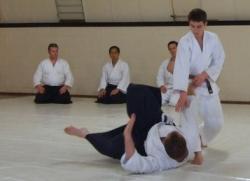 By about the grade of Yonkyu I was much more comfortable at the Dojo, and probably much less smartassed. Then came my Sankyu grading, which was very exciting, far more intense than any of my previous gradings, due mainly to the sheer quantity of techniques I was required to know, and of course because Jiyuu Waza was in the syllabus. The grading was less thorough than the rigourous proficiency tests I had sat, and I was not required to do Jiyuu Waza, which was both a relief and a let down. Once again, my Aikido environment changed totally once I began to wear a brown belt. Holes were picked mercilessly in my techniques, and I sometimes resorted to using strength in place of technique (not that I had much strength to use) and this rarely sufficed. I think my training reached its peak some time, possibly when I was a Sankyu, but more likely a Nikkyu, and this was certainly what got me through my Nikkyu and Ikkyu gradings in relative comfort (although my Ikkyu grading was slightly less spectacular than I believe I was capable of at the time), and then for six months or so I was a complacent Ikkyu, with no grading to concern me for another year. This was the time in which my heavy training would have paid off the most, but unfortunately I was without the pressure or excitement of an upcoming grading, and I discovered some new, time consuming hobbies. My training became less regular, although not drastically, but probably significantly. I still haven’t got back in to Friday morning classes.
By about the grade of Yonkyu I was much more comfortable at the Dojo, and probably much less smartassed. Then came my Sankyu grading, which was very exciting, far more intense than any of my previous gradings, due mainly to the sheer quantity of techniques I was required to know, and of course because Jiyuu Waza was in the syllabus. The grading was less thorough than the rigourous proficiency tests I had sat, and I was not required to do Jiyuu Waza, which was both a relief and a let down. Once again, my Aikido environment changed totally once I began to wear a brown belt. Holes were picked mercilessly in my techniques, and I sometimes resorted to using strength in place of technique (not that I had much strength to use) and this rarely sufficed. I think my training reached its peak some time, possibly when I was a Sankyu, but more likely a Nikkyu, and this was certainly what got me through my Nikkyu and Ikkyu gradings in relative comfort (although my Ikkyu grading was slightly less spectacular than I believe I was capable of at the time), and then for six months or so I was a complacent Ikkyu, with no grading to concern me for another year. This was the time in which my heavy training would have paid off the most, but unfortunately I was without the pressure or excitement of an upcoming grading, and I discovered some new, time consuming hobbies. My training became less regular, although not drastically, but probably significantly. I still haven’t got back in to Friday morning classes.
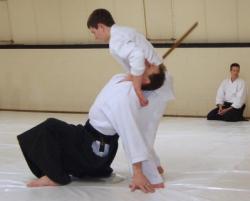 That about brings me up to present day. I am now a sixteen-year-old Ikkyu, awaiting my Shodan grading in slightly under four months and training regularly again. As a teenage boy, I am not yet worried about my Shodan grading. Four months is a long time away when you spend each day wondering about what you’re going to do in the weekend, but I’m sure I’ll be worried closer to the date. To be honest, I don’t find gradings in general too intense, especially when compared to piano exams – those things are the worst. Of course NCEA exams are just a joke, as in most cases you’ve already gained enough internals due to the unlimited resits to only need to score around 20% of the credits in the externals. The thing about grading is that you know you’re capable, you’ve just got to not screw it up on the day, especially not by breeching etiquette.
That about brings me up to present day. I am now a sixteen-year-old Ikkyu, awaiting my Shodan grading in slightly under four months and training regularly again. As a teenage boy, I am not yet worried about my Shodan grading. Four months is a long time away when you spend each day wondering about what you’re going to do in the weekend, but I’m sure I’ll be worried closer to the date. To be honest, I don’t find gradings in general too intense, especially when compared to piano exams – those things are the worst. Of course NCEA exams are just a joke, as in most cases you’ve already gained enough internals due to the unlimited resits to only need to score around 20% of the credits in the externals. The thing about grading is that you know you’re capable, you’ve just got to not screw it up on the day, especially not by breeching etiquette.
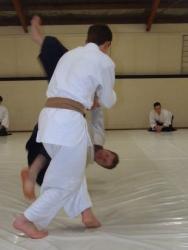 As an upcoming Shodan, I am quietly confident that my technique will be sufficient for grading, but as Andrew says, I must have a greater sense of Budo in my proficiency tests and grading, which roughly translates to “smash Uke harder” (watch out, Shane the Ogre! – ed). This is similar to what Andrew said before I attempted Sankyu, and I am sure I can achieve this. I’ll practice on David. Sorry to disappoint, but November is always a particularly stressful month, and although I am sure I will be worried about my grading nearer to the event, I am not too concerned at present, although I am trying to train more often. Of course, when I get my Shodan, I become fair game for Shihan, so say many senior club members, and this in itself is far more worrying than grading. I remember what it was like becoming a Rokkyu, and later becoming a Sankyu, and I expect that Shodan will come with all the surprises that a new belt has brought me previously.
As an upcoming Shodan, I am quietly confident that my technique will be sufficient for grading, but as Andrew says, I must have a greater sense of Budo in my proficiency tests and grading, which roughly translates to “smash Uke harder” (watch out, Shane the Ogre! – ed). This is similar to what Andrew said before I attempted Sankyu, and I am sure I can achieve this. I’ll practice on David. Sorry to disappoint, but November is always a particularly stressful month, and although I am sure I will be worried about my grading nearer to the event, I am not too concerned at present, although I am trying to train more often. Of course, when I get my Shodan, I become fair game for Shihan, so say many senior club members, and this in itself is far more worrying than grading. I remember what it was like becoming a Rokkyu, and later becoming a Sankyu, and I expect that Shodan will come with all the surprises that a new belt has brought me previously.
Alex Palmer
Christchurch
Dunedin Seminar & Grading (aka Operation Deepfreeze)
Well, where do I start? Hhhhmm!!
How about the lack of passengers in my car for the trip down to Dunedin?? At one stage, a month or so before the trip south, I had a car full of people ready to go and have a great Aikido weekend. i.e. myself and three/four passengers. When the time came to actually drive out of Christchurch on Friday June 22nd I only had Eric and myself in the car. Bummer huh?
Firstly, I’m not having a dig at the guys for not coming with us – I’m just going to state a fact. We could have used the weight, dammit! You should have seen the snow down there! Remember that huge snowstorm that rattled Dunedin a while ago? Well, we drove straight into it. Not very wise?? Well, I’m not sure about that, but we probably should have thought about going south a bit more seriously than we did, that’s for sure, and I think Eric will agree with me here.
We arrived at Grant and Megan Doherty’s’ house (our hosts) mid afternoon on the 22nd June. By 9:00pm, there was approximately three inches of snow on the ground (how exciting I thought!!…….being a country boy from Central Australia!!)
Saturday 23rd June – well, excitement soon turned to doubt the next morning. There was another three inches of snow on the ground, no power at all, and we had to get down the mountain that Grant and Megan live on to get to the Dojo in Dunedin. Bummer!! Also, it turns out that Andrew was stuck at the airport in Christchurch, waiting for his flight to leave for Dunedin – delayed because of the foul weather Dunedin was experiencing. Double Bummer!!!!
After breakfast, by a very warm and cozy fire, with Grant, Megan and their two kids (many thanks to Megan here – she is a very well organised Southern Lady!), we set off down the mountain on our journey to the Aikido Shinryukan Otago Dojo. Four wheel drive all the way down! I think I remember Grant saying the downhill trip to Port Chalmers usually took about 12-15 minutes. This particular morning, it took around 45 minutes. We had to go really slow because of all the slush, snow and ice on the road. I was pretty worried during the decent and I think Grant and Eric could vouch for that. But, Grant’s skill with his nimble 4×4 got us down safely to Port Chalmers and from there it was a fairly easy trip into Dunedin to the Dojo. I remember thinking though ”We have to get back up there at some stage later on today; I wonder how we’ll go??” As it happens, it was ok going up too. Whew!!
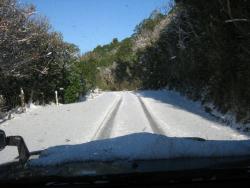
Andrew Sensei was late in leaving Christchurch so I ended up taking the first class until he turned up. Numbers on the mat were thin because a lot of the people who had planned to attend the Seminar couldn’t actually get to the Dojo because of the weather. Aikido students from Wanaka, Queenstown and Alexandra had no hope of reaching Dunedin that weekend because Central Otago was completely isolated by the volume of snow on the ground. Even some of the Dunedin Students couldn’t make it to class either. But, overall, a good time was had by those in attendance on that first morning of training.
While this was all happening, my little 2 wheel drive Toyota Rav 4 was sitting outside on the top of Grant and Megan’s mountain – snowed in!! I kept thinking Eric and I might have to fly home, if aircraft were still flying by the time we have to leave the next day. How the hell was I going to get my car home to Christchurch, and how long would I be stuck at home without it??
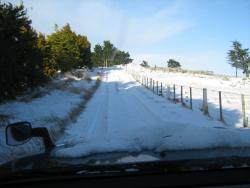
Sunday 24th. June – Grading Day. The Gradings went very well. Andrew Sensei was pleased with everybody and pleased with the overall standard of the Dunedin students. All credit to the instructors down there i.e. Alex, Grant, Erin, Shane and Guy. Well done troops! It was certainly good to watch from where I was sitting. I think the Students who impressed me most were the two highest grades of the day – Jun and Monty. Well done guys. I have always enjoyed watching Jun and I look forward to his Shodan (grading) in the near future. Monty was excellent as well and has powerful technique and I must say both students are assets to the Dunedin Dojo already.
After the grading, Eric and I looked at each other and I said to him ”Shall we make a run for it to Christchurch?” (while there was a break in the weather) and he said “Git R Done” (a Rangiora saying a couple of us have adopted from an American Comedian) which meant “Hell yeah!! Let’s do it!” So, we made our apologies, thanked everybody, and got the hell out of there before we ended up being stuck again!! As we filled up with petrol at the BP Service Station in the main street, the weather closed in and snow started to fall again! No time to lose – we had to get over the Killmog, which is huge hill on the outskirts of Dunedin. If it snows heavily, you don’t get up this hill unless you have chains or a four wheel drive. But, as it happened, the hill was relatively snow-free at that stage and we made it back home to Christchurch ok.
I’ll really have to think seriously about doing that trip again in the middle of a huge southerly weather pattern. It is certainly dangerous but, on the other hand, (it was) very beautiful as well. It’s almost worth it for the winter scenery. Time will tell for sure. We’ll see what happens next time.
Kevin Allen
Christchurch
THE IMPORTANCE OF STRETCHES FOR AIKIDO PRACTICE
Whether you’re new to Aikido or have been doing it for years, taking a few minutes to stretch is still important.
Aikido is an activity which uses nearly every muscle in the body, so it’s paramount that we are prepped and primed for training, even if we are taking it easy! A cold muscle doesn’t stretch as well as a warm pre-stretched one. Imagine warm toffee and cold toffee, which one stretches!? Most muscular strains seem to occur at the start of a class, not at the end. Though you feel it at the end, and sometimes the next day, when you cool down again
Reflexes within a muscle react to protect it from any sudden increase in lengthening by making the muscle contract to prevent it being pulled too long too quickly. This is when a muscle can be strained or termed ‘pulled’, and why we should only stretch to a comfortable zone, not into pain!
Commonly, we see the same basic stretches in every Aikido dojo around the world; these have been used and practiced throughout the history of Aikido and its preceding roots and passed down from instructor to instructor, because they work. Think about it for a second – wrists, shoulders, neck, back, abdominals, hips, knees and ankles all get attention before the class starts. These exercises create strength in the ligaments around joints and flexibility throughout the body to prepare you for the class ahead.
For Beginners
Begin the class slowly while gently increasing the demands placed on your body. If you see senior grades throwing themselves into ukemi (receiving, falling) practice, remind yourself, they’ve been doing Aikido a little longer…..their bodies are more used to these demands.
For more senior members (6 -12mths plus)
Use caution, you should be developing an idea of what your body can and cannot handle.
For Seniors
Keep an eye on the more junior grades, help them understand that starting the class slowly and increasing their training pace is safest.
The most common muscles to suffer strains are the Hamstrings (back of the upper leg) and the Calf, showing that hip flexibility is important for Aikido and everyday life. Bending forward to take ukemi challenges both of these muscles, and as mentioned above, that’s when you’ll know if you’ve stretched and warmed up enough! If you are concerned about your flexibility, take the time after class to stretch it out while the muscles are warm.
Remember, “Prevention is better than Cure”.
Hamstring Partner Stretch
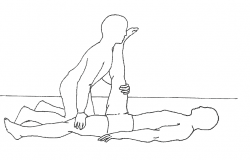
Communication with your stretch partner is important; use them for support only. Don’t let them overstretch you, they offer resistance only, you are in charge! Keep the non-stretched side on the floor, and the stretched leg relatively straight. Hold until you feel the stretch ease, then increase the movement and keep it comfortable.
Hamstring, Calf and Adductor Self Stretch
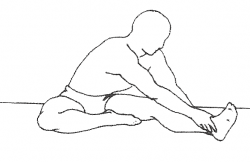
Keep the stretched leg relatively straight and foot vertical (vary the foot and body position to move the stretch). Tip your pelvis forward from the top to target the Hamstring. You may also target the calf by either taking hold of the front of the foot or using a belt around the ball of the foot if you can’t reach (adjust by straightening and bending the knee). Hold until you feel the stretch ease, then increase the movement and keep it comfortable.
*You can add an Adductor stretch by placing one hand on the bend knee and targeting the inside thigh of that leg.
Calf Specific Self Stretch
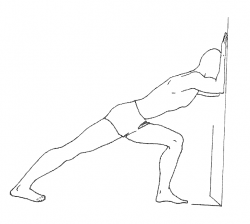
You don’t need a wall, but it can help to push against. Keep the foot of the stretched side flat on the floor. Push the knee back and the heel down as you apply the stretch. You can also target the lower calf by bending the stretched knee keeping the foot flat on the floor, you will need to move the foot forward. Hold until you feel the stretch ease, then increase the movement and keep it comfortable.
Alex Frederiksen
Massage Therapist
SOME LIGHTER MOMENTS
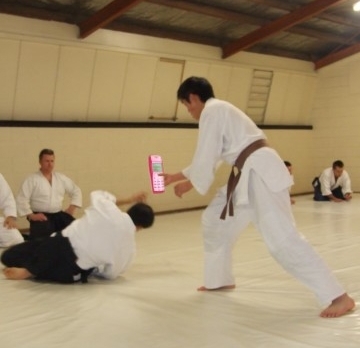 100X Happy Birthday Sensei!!
100X Happy Birthday Sensei!!
txttxttxttxttxttxttxttxttxttxttxttxttxttxttxttxttxttxt
STOPPED BY A YONKYO!

